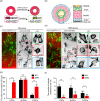Simulated microgravity reduces quality of ovarian follicles and oocytes by disrupting communications of follicle cells
- PMID: 36690655
- PMCID: PMC9870914
- DOI: 10.1038/s41526-023-00248-5
Simulated microgravity reduces quality of ovarian follicles and oocytes by disrupting communications of follicle cells
Abstract
Ovarian follicles are the fundamental structures that support oocyte development, and communications between oocytes and follicle somatic cells are crucial for oogenesis. However, it is unknown that whether exposure to microgravity influences cellular communications and ovarian follicle development, which might be harmful for female fertility. By 3D culturing of ovarian follicles under simulated microgravity (SMG) conditions in a rotating cell culture system, we found that SMG treatment did not affect the survival or general growth of follicles but decreased the quality of cultured follicles released oocytes. Ultrastructure detections by high-resolution imaging showed that the development of cellular communicating structures, including granulosa cell transzonal projections and oocyte microvilli, were markedly disrupted. These abnormalities caused chaotic polarity of granulosa cells (GCs) and a decrease in oocyte-secreted factors, such as Growth Differentiation Factor 9 (GDF9), which led to decreased quality of oocytes in these follicles. Therefore, the quality of oocytes was dramatically improved by the supplementations of GDF9 and NADPH-oxidase inhibitor apocynin. Together, our results suggest that exposure to simulated microgravity impairs the ultrastructure of ovarian follicles. Such impairment may affect female fertility in space environment.
© 2023. The Author(s).
Conflict of interest statement
The authors declare no competing interests.
Figures






Similar articles
-
Stage-dependent effects of oocytes and growth differentiation factor 9 on mouse granulosa cell development: advance programming and subsequent control of the transition from preantral secondary follicles to early antral tertiary follicles.Biol Reprod. 2004 May;70(5):1253-62. doi: 10.1095/biolreprod.103.023937. Epub 2003 Dec 26. Biol Reprod. 2004. PMID: 14695909
-
Matrix-free 3D culture supports human follicular development from the unilaminar to the antral stage in vitro yielding morphologically normal metaphase II oocytes.Hum Reprod. 2021 Apr 20;36(5):1326-1338. doi: 10.1093/humrep/deab003. Hum Reprod. 2021. PMID: 33681988 Free PMC article.
-
Growth and differentiation factor 9 promotes oocyte growth at the primary but not the early secondary stage in three-dimensional follicle culture.J Assist Reprod Genet. 2016 Aug;33(8):1067-77. doi: 10.1007/s10815-016-0719-z. Epub 2016 May 7. J Assist Reprod Genet. 2016. PMID: 27155601 Free PMC article.
-
Cellular basis for paracrine regulation of ovarian follicle development.Reproduction. 2001 May;121(5):647-53. doi: 10.1530/rep.0.1210647. Reproduction. 2001. PMID: 11427152 Review.
-
Oocyte-somatic cell interactions in the human ovary-novel role of bone morphogenetic proteins and growth differentiation factors.Hum Reprod Update. 2016 Dec;23(1):1-18. doi: 10.1093/humupd/dmw039. Epub 2016 Oct 26. Hum Reprod Update. 2016. PMID: 27797914 Free PMC article. Review.
Cited by
-
The Oxidative Phosphorylation and Cytoskeleton Proteins of Mouse Ovaries after 96 Hours of Hindlimb Suspension.Life (Basel). 2023 Dec 12;13(12):2332. doi: 10.3390/life13122332. Life (Basel). 2023. PMID: 38137934 Free PMC article.
-
Exploring the Idea of Human Reproduction in Space: A Potential Area for Future Research.Cureus. 2024 Nov 14;16(11):e73712. doi: 10.7759/cureus.73712. eCollection 2024 Nov. Cureus. 2024. PMID: 39677198 Free PMC article. Review.
-
Omics Studies of Tumor Cells under Microgravity Conditions.Int J Mol Sci. 2024 Jan 11;25(2):926. doi: 10.3390/ijms25020926. Int J Mol Sci. 2024. PMID: 38255998 Free PMC article. Review.
-
Effects of Simulated Microgravity In Vitro on Human Metaphase II Oocytes: An Electron Microscopy-Based Study.Cells. 2023 May 9;12(10):1346. doi: 10.3390/cells12101346. Cells. 2023. PMID: 37408181 Free PMC article.
-
Microgravity and Cellular Biology: Insights into Cellular Responses and Implications for Human Health.Int J Mol Sci. 2025 Mar 27;26(7):3058. doi: 10.3390/ijms26073058. Int J Mol Sci. 2025. PMID: 40243850 Free PMC article. Review.
References
-
- McGee, E. A. & Hsueh, A. J. W. Initial and cyclic recruitment of ovarian follicles. Endocr. Rev.21, 200–214 (2000). - PubMed
LinkOut - more resources
Full Text Sources

